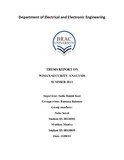| dc.contributor.advisor | Kazi, Sadia Hamid | |
| dc.contributor.advisor | Rahman, Rumana | |
| dc.contributor.author | Saeed, Nuha | |
| dc.contributor.author | Munira, Mahfuza | |
| dc.date.accessioned | 2011-11-15T10:56:21Z | |
| dc.date.available | 2011-11-15T10:56:21Z | |
| dc.date.copyright | 2011 | |
| dc.date.issued | 2011-04-28 | |
| dc.identifier.other | ID 08110102 | |
| dc.identifier.other | ID 08110039 | |
| dc.identifier.uri | http://hdl.handle.net/10361/1470 | |
| dc.description | This thesis report is submitted in partial fulfillment of the requirements for the degree of Bachelor of Science in Electrical and Electronic Engineering, 2011. | |
| dc.description | Cataloged from PDF version of thesis report. | |
| dc.description | Includes bibliographical references (page 31). | |
| dc.description.abstract | Worldwide Interoperability for Microwave Access (WiMAX) is a wireless metropolitan area network (WMAN) communications technology using the IEEE 802.16 standard. The original purpose of IEEE 802.16 technologies was to provide last-mile broadband wireless access as an alternative to cable, digital subscriber line (DSL). Developments in the IEEE 802.16 standard shifted the technology’s focus toward a more cellular-like, mobile architecture to serve a broader market.
WiMAX network threats focus on compromising the radio links between WiMAX nodes. These radio links support both line-of-sight (LOS) and non-line-of-sight (NLOS) signal propagation. Links from LOS WiMAX systems are generally harder to attack than those from NLOS systems because an adversary would have to physically locate equipment between the transmitting nodes to compromise the confidentiality or integrity of the wireless link. WiMAX NLOS systems provide wireless coverage over large geographic regions, which expand the potential staging areas for both clients and adversaries. Like other wireless networking technologies, all WiMAX systems are susceptible to denial of service attacks, eavesdropping, man-in-the-middle attacks, message modification, and resource misappropriation.
In our report we are now going to explain the working technique of WiMAX and about the
related security threats. Then we are going to show some plans that we are going to fulfill in our Thesis semester to solve the security threats as much as possible. | en_US |
| dc.description.statementofresponsibility | Nuha Saeed | |
| dc.description.statementofresponsibility | Mahfuza Munira | |
| dc.format.extent | 31 pages | |
| dc.language.iso | en | en_US |
| dc.publisher | Department of Electrical and Electronic Engineering | en_US |
| dc.rights | BRAC University thesis are protected by copyright. They may be viewed from this source for any purpose, but reproduction or distribution in any format is prohibited without written permission. | |
| dc.subject | Electrical and electronic engineering | |
| dc.title | Wimax security analysis | en_US |
| dc.type | Thesis | en_US |
| dc.contributor.department | Department of Electrical and Electronic Engineering, BRAC University | |
| dc.description.degree | B. Electrical and Electronic Engineering | |

